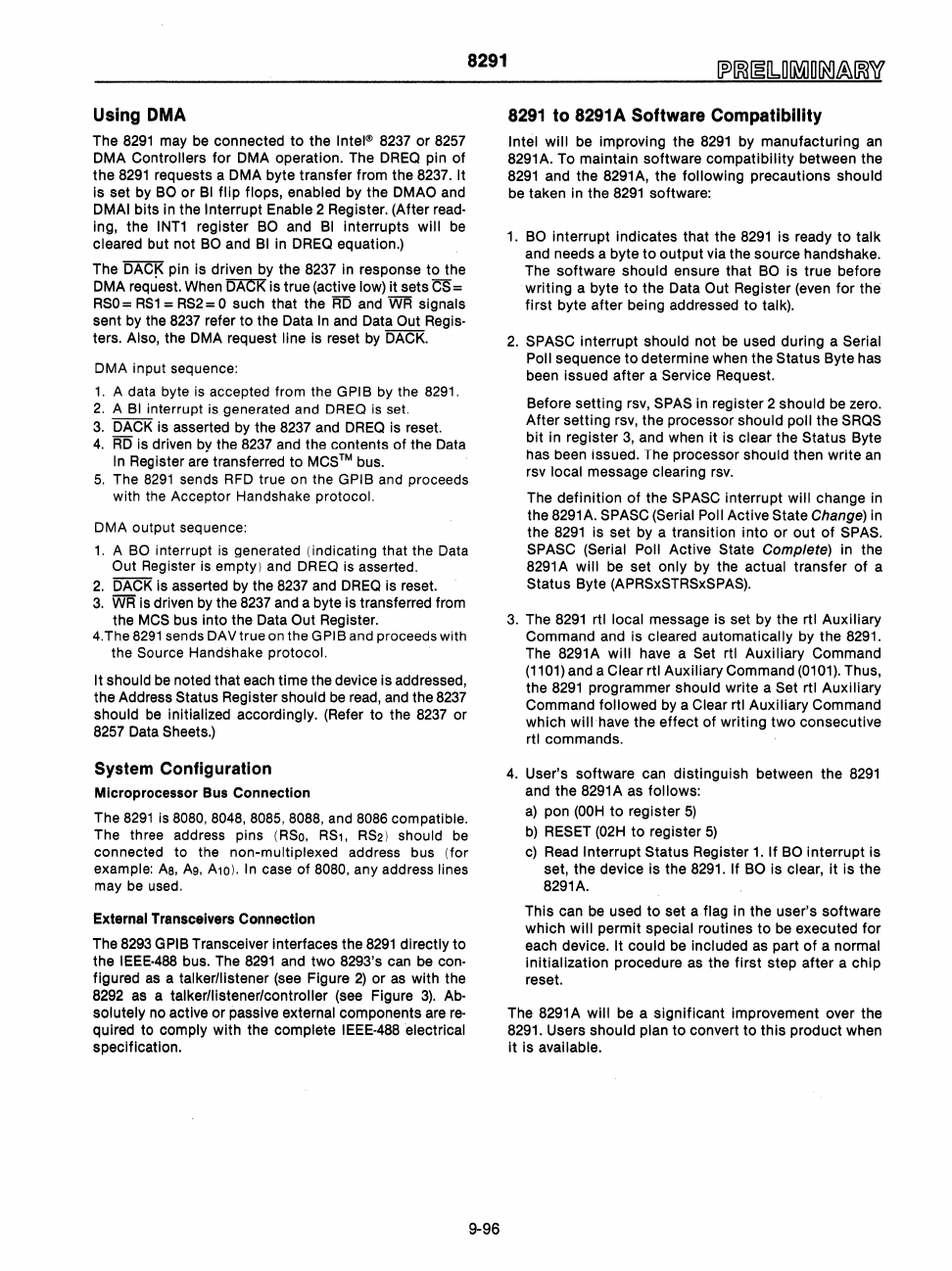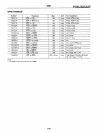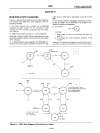
8291
Using DMA
The
8291
may be connected
to
the
Intel<l>
8237
or
8257
DMA
Controllers for DMA operation. The
DREO
pin of
the
8291
requests a DMA byte transfer from the 8237. It
Is
set by BO
or
BI
flip
flops, enabled by the DMAO and
DMAI bits In the Interrupt Enable 2 Register. (After read·
ing, the
INT1
register
BO
and
BI
interrupts
will
be
cleared but not
BO
and
BI
In DREO equation.)
The DACK pin
Is driven by the 8237 in response
to
the
DMA request. When
DACK
is true (active low)
it
sets
CS
=
RSO=
RS1
=
RS2=0
such that the m; and
WR
signals
sent by the
8237
refer
to
the Data
In
and Data Out Regis·
ters. Also, the DMA request line is reset by DACK.
DMA input sequence:
1.
A data byte is accepted from the GPIB by the
8291.
2.
A
BI
interrupt is generated and DREO is set.
3.
DACK is asserted
by
the 8237 and
DREO
is reset.
4.
RD
is driven bv the
8237
and the contents
of
the Data
In
Register are transferred
to
MCS™ bus.
5.
The
8291
sends
RFD
true on the GPIB and proceeds
with the Acceptor Handshake protocol.
DMA output sequence:
1.
A BO interrupt
is
generated (indicating that
th.e
Data
Out Register is empty) and DREO is asserted.
2.
DACK Is asserted by the 8237 and
DREO
is reset.
3.
ii'm
Is driven by the
8237
and a byte Is transferred from
the
MCS
bus Into the Data Out Register.
4.
The
8291
sends DAV true on the GPIB and proceeds with
the
Source Handshake protocol.
It
should be noted that each time the device is addressed,
the Address
Status Register should be read, and the
8237
should
be
initialized accordingly. (Refer
to
the
8237
or
8257 Data Sheets.)
System Configuration
Microprocessor Bus Connection
The
8291
is
8080,
8048, 8085, 8088,
and 8086 compatible.
The three address pins
(RSo.
RS1,
RS2)
should
be
connected to the non-mUltiplexed address bus (for
example:
As.
Ag,
A10).
In case of 8080, any address lines
may be used.
External Transceivers Connection
The 8293
GPIB Transceiver interfaces the
8291
directly
to
the IEEE·488 bus. The
8291
and two 8293's can be con·
figured
as
a talker/listener (see Figure
2)
or
as
with the
8292 as a talker/listener/controller (see Figure
3).
Ab·
solutely no active
or
passive external components are
re-
quired to comply with the complete IEEE·488 electrical
specification.
9-96
8291
to
8291A Software Compatibility
Intel
will
be improving the
8291
by manufacturing an
8291A. To maintain software
compatibility
between the
8291
and the 8291A, the following precautions should
be taken
In
the
8291
software:
1.
BO
interrupt indicates that the
8291
is ready
to
talk
and needs a byte
to
output
via the source handshake.
The software should ensure that
BO
is true before
writing
a byte
to
the Data Out Register (even
for
the
first byte after being addressed
to
talk).
2.
SPASC interrupt should not be used during a Serial
Poll sequence
to
determine when the Status Byte has
been issued after a
Service Request.
Before setting rsv,
SPAS in.register 2 should be zero.
After
setting rsv, the processor should poll the SROS
bit in register
3,
and when it is clear the Status Byte
has been
Issued. The processor should then write
an
rsv local message clearing rsv.
The
definition
of
the SPASC interrupt will change in
the
8291
A.
SPASC (Serial Poll Active State Change) in
the
8291
is set by a transition
into
or
out
of
SPAS.
SPASC (Serial Poll
Active State Complete) in the
8291A
will
be set only by the actual transfer
of
a
Status Byte (APRSxSTRSxSPAS).
3.
The
8291
rtl local message is set by the rtl Auxiliary
Command and is cleared automatically by the 8291.
The 8291A
will
have a Set rtl Auxiliary Command
(1101)
and a Clear rtl Auxiliary Command
(0101).
Thus,
the
8291
programmer should write a Set rtl Auxiliary
Command
followed by a Clear rtl Auxiliary Command
which
will have the effect
of
writing two consecutive
rtl commands.
4.
User's software can distinguish between the
8291
and the 8291A as follows:
a)
pon
(OOH
to
register
5)
b)
RESET (02H
to
register
5)
c)
Read Interrupt Status Register
1.
If
BO interrupt is
set, the device
is
the
8291.
If BO is clear, It is the
8291A.
This can be used
to
set
a.11ag
in the user's software
which
will permit special routines
to
be executed for
each device.
It
could be Included as part
of
a normal
initialization procedure as the first step after a chip
reset.
The 8291A will be a significant improvement over the
8291. Users should plan
to
convert
to
this
product when
It
is available.


















